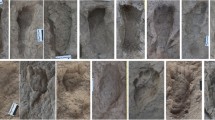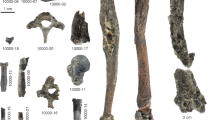Abstract
The ability to stand upright and walk on two legs is widely recognized as a crucial hominid adaptation that had profound effects on the course of human evolution. The relief of the upper limb from the task of supporting the trunk in locomotion would have permitted the efficient carriage of food, infants and later tools and weapons. Any or all of these activities could, it is believed, have improved the differential survival of early hominids. Precisely when upright stance and bipedal gait were first acquired within the hominid evolutionary line is not known, and so the discovery of apparently bipedal footprints of Pliocene age at site G, Laetoli, Tanzania is important in itself1,2. A study of the footprints, reported here, has shown that when these hominids walked, they transmitted their body weight and the forces of propulsion to the ground in a manner very similar to that of modern man.
Similar content being viewed by others
References
Leakey, M. D. Antiquity 52, 133 (1978).
Leakey, M. D. & Hay, R. L. Nature 278, 317 (1979).
Broom, R., Robinson, J. T. & Schepers, G. W. H. Trans. Mus. Mem. 4 (1950).
Napier, J. R. Arch. Biol. Liège 75, Suppl. 673 (1964).
Davis, P. R. Nature 201, 967 (1964).
Day, M. H. & Napier, J. R. Nature 201, 967 (1964).
Day, M. H. & Napier, J. R. Nature 211, 929 (1966).
Day, M. H. Nature 215, 323 (1967).
Day, M. H. Nature 221, 230 (1969).
Day, M. H. in Earliest man and the Environment of the Lake Rudolf Basin (eds Coppens, Y., Howell, F. Clark, Isaac, Glynn L1. & Leakey, R. E. F.) (Chicago University Press, 1976).
Johanson, D. C. & Taieb, M. Nature 260, 293 (1976).
Dart, R. A. Am. J. Phys. Anthrop. 7, 301 (1949).
Clark, W. E. Le Gros The Fossil Evidence for Human Evolution (The University of Chicago Press, 1955).
Robinson, J. T. Early Hominid Posture and Locomotion (Chicago University Press, 1972).
Day, M. H. Symp. zool. Soc. 33, 29 (1972).
Zuckerman, S. et al. Symp. zool. Soc 33, 71 (1972).
Lovejoy, C. O. & Heiple, K. G. Nature 235, 175 (1972).
Barnett, C. H. Lancet i, 617 (1956).
Author information
Authors and Affiliations
Rights and permissions
About this article
Cite this article
Day, M., Wickens, E. Laetoli Pliocene hominid footprints and bipedalism. Nature 286, 385–387 (1980). https://doi.org/10.1038/286385a0
Received:
Accepted:
Issue Date:
DOI: https://doi.org/10.1038/286385a0
- Springer Nature Limited
This article is cited by
-
Arched footprints preserve the motions of fossil hominin feet
Nature Ecology & Evolution (2023)
-
Snapshots of human anatomy, locomotion, and behavior from Late Pleistocene footprints at Engare Sero, Tanzania
Scientific Reports (2020)
-
Sexual dimorphism in Homo erectus inferred from 1.5 Ma footprints near Ileret, Kenya
Scientific Reports (2019)





